I love how my Roombas help keep pet hair picked up with a minimum of effort; and I’ve been fascinated by the idea of the Scooba, iRobot’s wet-mopping robot, since it was announced. I recently picked up a used 5900 in very nice condition on eBay from a wonderful seller who even included a spare battery.
I want to start with a pictorial overview, since I hadn’t seen enough Scooba pictures to understand how different it really is from the Roombas, then proceed to a few comments about my experience with it so far.
Tour Through Scooba
On the surface and from the top, Scooba looks very similar to a Roomba. It’s very slightly larger, but considerably heavier. The handle is used to carry Scooba, but also pushing it down unlatches the tank assembly to lift it out (shown further below).
The rotating brushes on the undercarriage look familiar. But note that the fore squeegee is supposed to keep loose material in the blower/vacuum trough forward of the brushes, and the brushes only scrub and aren’t really meant to pick up material.
The brush assembly slides out the starboard side instead of unclipping directly,
and it folds open to make it easier to clean. Cleaning, by the way, means rinsing under a faucet, not picking all the fluff and lint out by hand.
Scooba moves a lot slower than Roomba because it’s scrubbing the floor, not just passing over and sucking up loose stuff; and its wheels are correspondingly smaller for lower speed. They’re also made of some kind of foam with a diamond tread pattern cut into them, rather than Roomba’s knobby rubber tires. And their suspensions are changed such that the pivot points are inward along the axles rather than inline with the wheels.
Here start the major differences. Roomba’s dust bin is a smallish piece that unclips from the aft end, slides out the back, and dumps out. Scooba’s tank assembly hinges up and leaves Scooba looking like General Grievous’s head (can this possibly be deliberate???) with a lot more interesting things exposed.
The rubber schnozzle on the right is the vacuum tube from the trough on the undercarriage, and next to it is the button to unlatch the brush assembly. The two oblong holes mate with the oblong holes in the brush assembly and similar tubes on the underside of the tank (later) to deliver cleaning solution and remove dirty fluid from the floor.
Below and left of the starboard hole is the socket where the tank’s fluid sensor makes contact. Above and left of the brush eject button is what looks like a spindle to turn a tank pump, although I haven’t completely figured that out yet. The battery is in the center, hiding under the tank when in use, and well away from the liquids splashing about on the floor.
On the left side you can see the blower inlet that leads to the blower/vacuum trough on the undercarriage, with this filter installed.
The filter (upside-down here) slides into the trough and gathers any loose, dry dust (cat fur) floating around inside Scooba. (I haven’t quite figured out yet how that air flows through the tank assembly.) Although everything I’ve had in my filter has been dry, it’s made of metal screen and the easiest way to clean it is rinse it out under running water, a running theme of the Scooba.
Also note that the tip of my filter has been gnawed by the previous owner’s pet (cat or ferret?). This changes its shape enough that it falls right out of the blower tunnel when I pick up the base. When I have some time, I’ll put a dab of RTV on the chewed tip to aid in gripping the tunnel walls.
Removing the tank from the base exposes the tank’s fill and drain caps. Clean solution goes in the right; dirty water comes out the left.
On the underside of the tank, you can see the air path that sucks debris up through the rubber schnozzle on the starboard side and blows air out the trough on the port side, as well as the oblong holes for liquid delivery and pickup, the spindle’s mating part, and the fluid detector plug in the upper left of the lighter blue, opaque part.
Not visible, the tank has internal valves that keep the liquid contained inside it regardless of position — you don’t have to be über-careful moving it from the sink to Scooba and from Scooba to pour out. However, shaking (as when rinsing the dirty tank after use) does open a flapper between the dirty tank and the air path (interesting, wot?), so be prepared.
Back to the base, I found this little gem hidden behind a rubber plug toward the starboard end. I haven’t checked yet whether it’s compatible with Roomba’s serial port. It’s covered by the tank when in operation, so it wouldn’t be practical for connecting to and controlling Scooba as a cleaning ‘bot, but rather only for taking over Scooba as a general-purpose mobile base.
Finally, Scooba’s virtual walls look just like Roomba’s except for color scheme. I assume they’re compatible (except for Scheduler enhancements), but haven’t actually checked yet.
I find it mildly interesting that Scooba’s distance label reads “ 4-7′ ” and Roomba’s reads “ 4′-7′ ”. Who thought that was important enough to make a point of changing it?
Thank you very much, ladies and gentleman, that concludes our tour. You’ll be exiting the cave through our gift shop — please feel free to buy souvenir postcards or have your picture taken with our life-size statues of Roomba, Scooba, and General Grievous. We hope you enjoyed the tour, and enjoy your stay in Branson.
Cleaning Fluid
iRobot contracted with Clorox to develop a special cleaning solution for Scooba, and I don’t have any of it yet. It’s supposed to be a low-foaming, non-slippery solution with a pleasant smell and enough conductivity to register in the tank sensor, and all of these are important factors for proper Scooba operation.
As noted in many places including a comment at a third-party Scooba blog, vinegar makes an adequate substitute for the Clorox solution. No foam, a little slippery, smells fantastic (if you have a fetish for acetic acid, which I don’t, thank you very much), and it registers in the tank. Pour in 2 fluid oz (4T) and fill the rest of the way with water, and you’re (fairly) good to go.
Since mine didn’t come with any Clorox solution and it doesn’t seem to be available in the Wichita area, I’ve been using vinegar (and trying to decide where to pay $5 shipping for a $7 bottle of fluid). Many Scooba owners rave about their shiny clean floors; I would note that this does not happen with the vinegar solution, which leaves my floors fairly dull. Hopefully the special Clorox solution makes them shiny sparkly beautiful.
My Scooba has been halting with bumper (“b”) and wheel (“d”) stuck problems near the edges of the kitchen, and I attribute this to the wheels spinning in the vinegar solution. I’ll find it sitting sideways against a wall in a position Roomba would simply turn away from, and my best guess is that it’s been trying but detected wheel slippage and no motion and decided it was stuck. Hopefully the Clorox solution permits Scooba better traction.
Also, some owners have complained that Scooba is extraordinarily sensitive to having the “correct” amount of cleaning solution (or vinegar) mixed with 1 qt of water — that is, that Scooba refused to recognize that the supply tank was full and ready to use with anything other than the exact recommended ratio of cleaning solution to water.
I had a “Check Tank” message once, and I buffed the tank sensor socket with 2000-grit sandpaper, reinstalled the tank, and started it right up. I think the oxidation on the contacts has a lot more to do with failure to detect adequate tank conductivity than the exact proportions of liquids in the mix.
Leaving Water on the Floor
The very first time I ran Scooba, it didn’t pick up any of the water. This fixya.com post put me on to the idea of putting hot water in the dirty tank and shaking, which got the flapper open. Scooba’s been picking up most of the water ever since.
For the record, it does leave a trail of water behind it on the floor, and I prefer not to walk through a wet room while it’s cleaning. But the parts of the floor that Scooba hasn’t traversed recently are already dry even before the whole room is finished; and except for dimples and low spots, it doesn’t take long at all for the floor to dry afterward.
Leave the fan off while Scooba’s running to give the first pass a chance to stay damp and soften any ground-in dirt, then turn on the ceiling fan or central air afterward and you’ll be just fine.
So How Well Does It Clean?
The iRobot Scooba manual brags about how much dirty water you’re going to pour out of the tank after Scooba cleans, and many Scooba owners positively glow talking about how they love to pour out the dirty water.
Um, in my book, a cleaning robot is not a device to generate dirty water. I can do that with dirt and water. My metric for cleaning robot performance is how clean it leaves my floors. I want to walk in afterward and say, “Wow, that’s clean!”
And on that point I’m mixed. The bathroom floor (vinyl) has dirt in its faux grout lines that’s been really hard to get out by hand; and as I’ve run Scooba in there repeatedly, I can tell the dirt is lightening every time, so it really is cleaning.
But the floors don’t shine, and I’ve been acculturated to believe that shininess is a sign of a clean floor. I’m optimistic that the magical Clorox solution will have magical shining properties heretofore unexperienced with mundane vinegar.
You need to vacuum first. As Scooba has the vacuum trough specifically to pick up loose materials, I find it disappointing that I need to run both Roomba and Scooba. But without prior vacuuming, every possible part of Scooba (blower filter, vacuum schnozzle, brushes, water ports) got clogged with wet or dry cat hair that I couldn’t even see was on my floor.
Finally, I can’t recommend strongly enough having two batteries. Scooba cleans until the supply tank is empty (unlike Roomba, which runs on a timer and/or by discovering the size of your room), which is slightly less than one battery’s worth of charge. That doesn’t mean the floor is now clean (and in fact if it was worth cleaning, it probably isn’t) — it means it has now used up 1 qt of water.
Get a second battery and keep them both charged on the external charger and as soon as Scooba empties the first tank, you can refill it and keep right on cleaning. ¡Muy bueno!
My kitchen floor now feels cleaner underfoot than it has in a long time, even after thorough vacuuming with Roomba, and my bathroom floor is looking better and better. I’m optimistic about the special Clorox cleaning solution doing an even better job and leaving a nice shine; and the bottom line is, not having gone in with unrealistic expectations, I’m very pleased with how Scooba is doing so far.
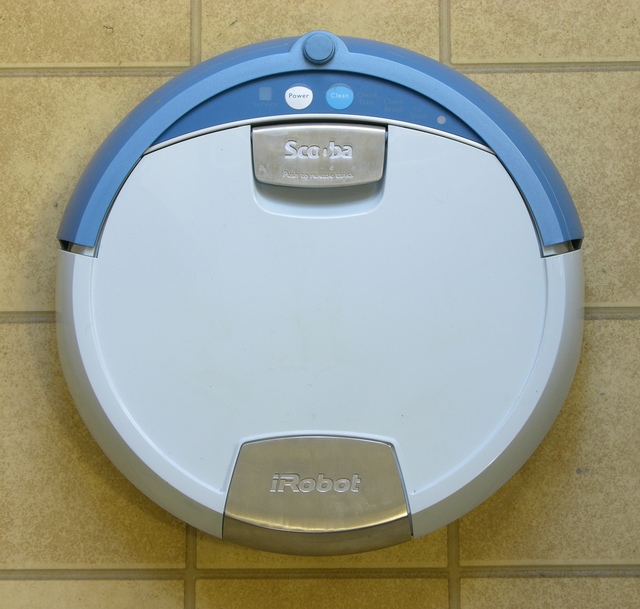
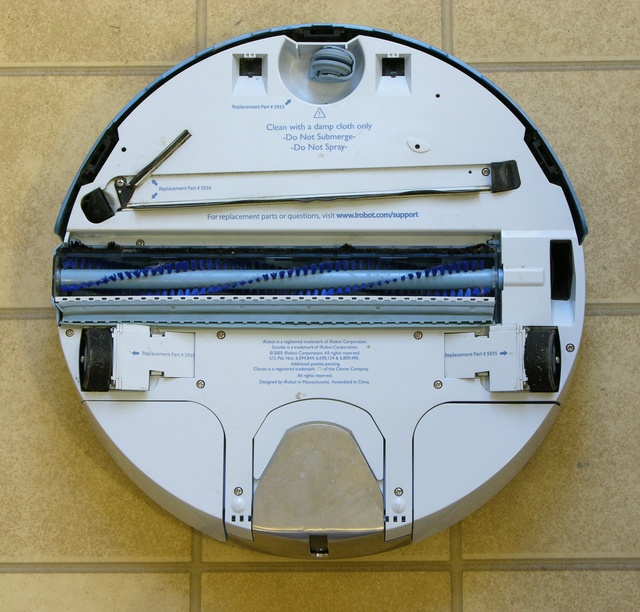
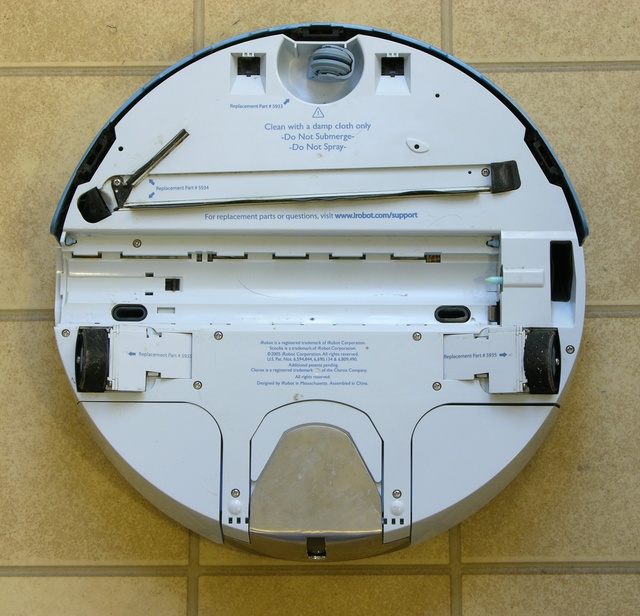
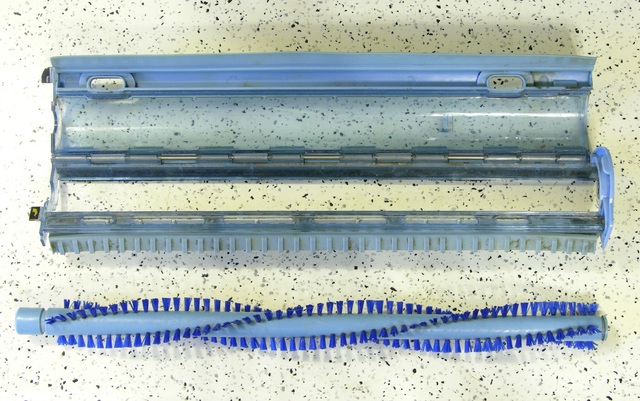
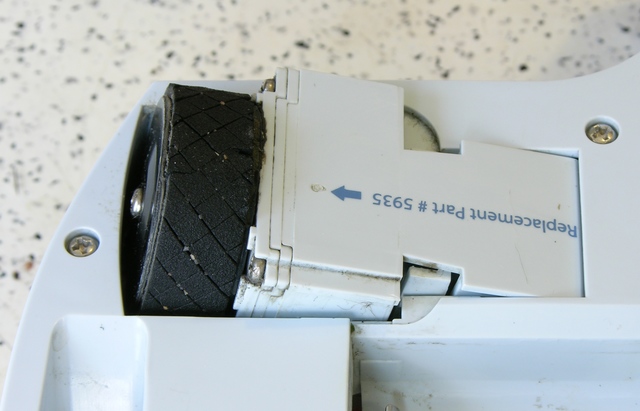
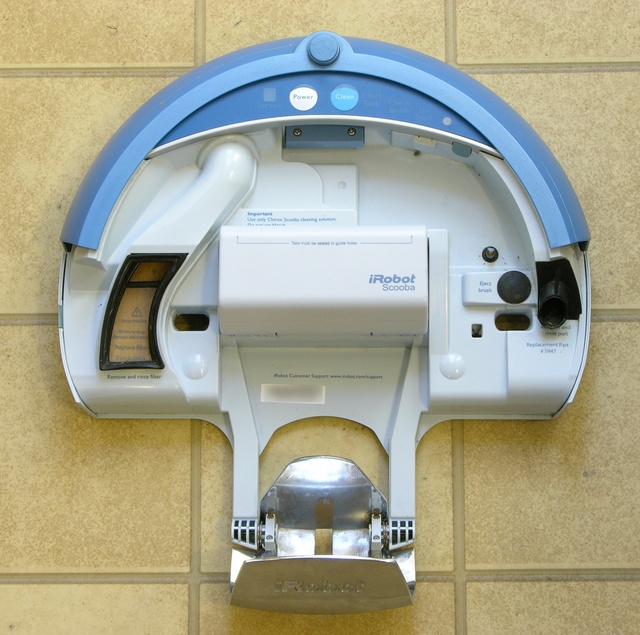
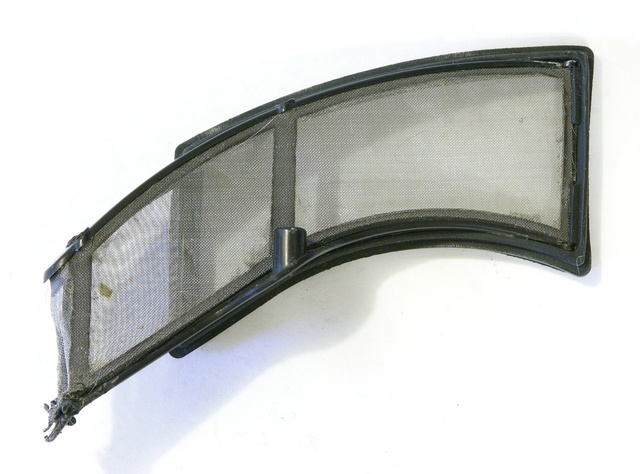
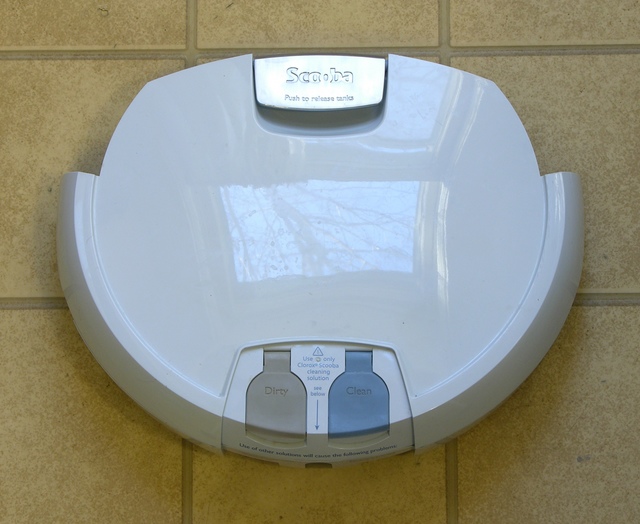
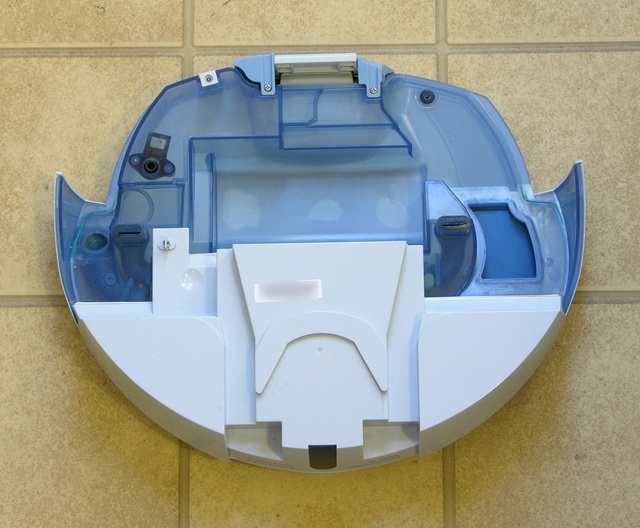
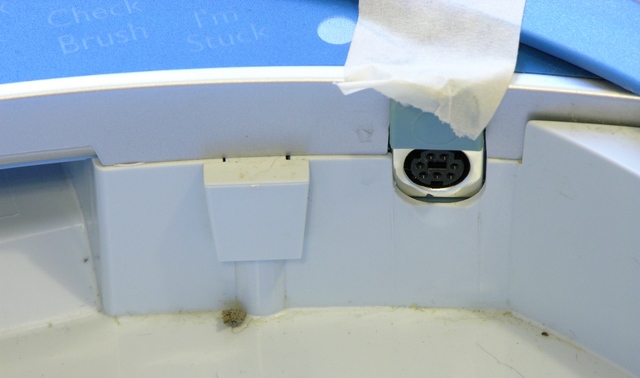
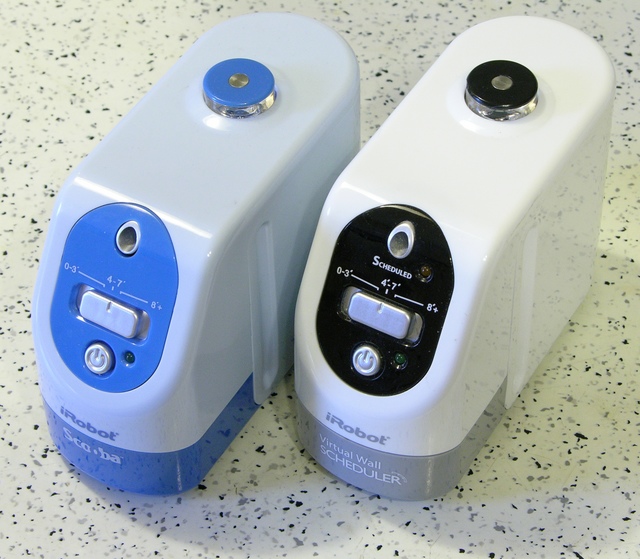
A couple of notes:
Upon further examination, the “spindle” doesn’t appear to be a spindle. It goes through a rubber fitting into the clean liquid supply tank and has no mechanical connection there. It doesn’t appear to turn. It looks hollow. I think it pressurizes air into the tank to force clean water out, or bleeds air into the tank to allow the clean water out.
And the blower filter actually kind of snaps into place, by pressing its tailing end down hard into the base. I think it wasn’t snapped in that way when I got it, so I don’t feel as silly for having missed that.
Hi! Just got a Scooba 5900 at a bargain price. It seems a little temperamental, but thus far it’s worth it. All the same, I’m wondering if you got better results with the Chlorox cleaner? The cleaner was shipped with my Scooba, and so I’ve yet to use vinegar. The first time I cleaned with Scooba and the special cleaner, I wasn’t very impressed with how clean my floors were. However, on the second and third pass, they did seem to shine a bit. I’m wondering if I’ll be disappointed when my cleaning fluid runs out, and I switch to vinegar, or if your floors just don’t get very shiny, and that accounts for your results.
Faith, my observations are that the Clorox cleaner is well worth it. It does take a few passes to get the floors clean and shining — but that’s more to do with how little cleaning liquid is being used across the whole floor.
When I was cleaning with vinegar before I got my Clorox, it appeared to be taking the shine off. The Clorox is definitely putting it on.
I hope Scooba works well for you!